Thymus praecox
A sweet smell of earthy, herby goodness wafts through the air, welcoming you into the garden. One step forward leads you onto a low-growing mat of spicy, lilac-flowering thyme.
Have no fear,Thymus praecox, aka creeping thyme, can handle a little foot traffic, releasing its sweet perfume in return, making it an excellent choice for planting in a walkway or between stepping stones!
An exceptional, pollinator-friendly ground cover,T. praecoxworks well to connect different spaces in a garden, as a border plant, in between stone paths, in a rock wall, or as a lawn substitute.
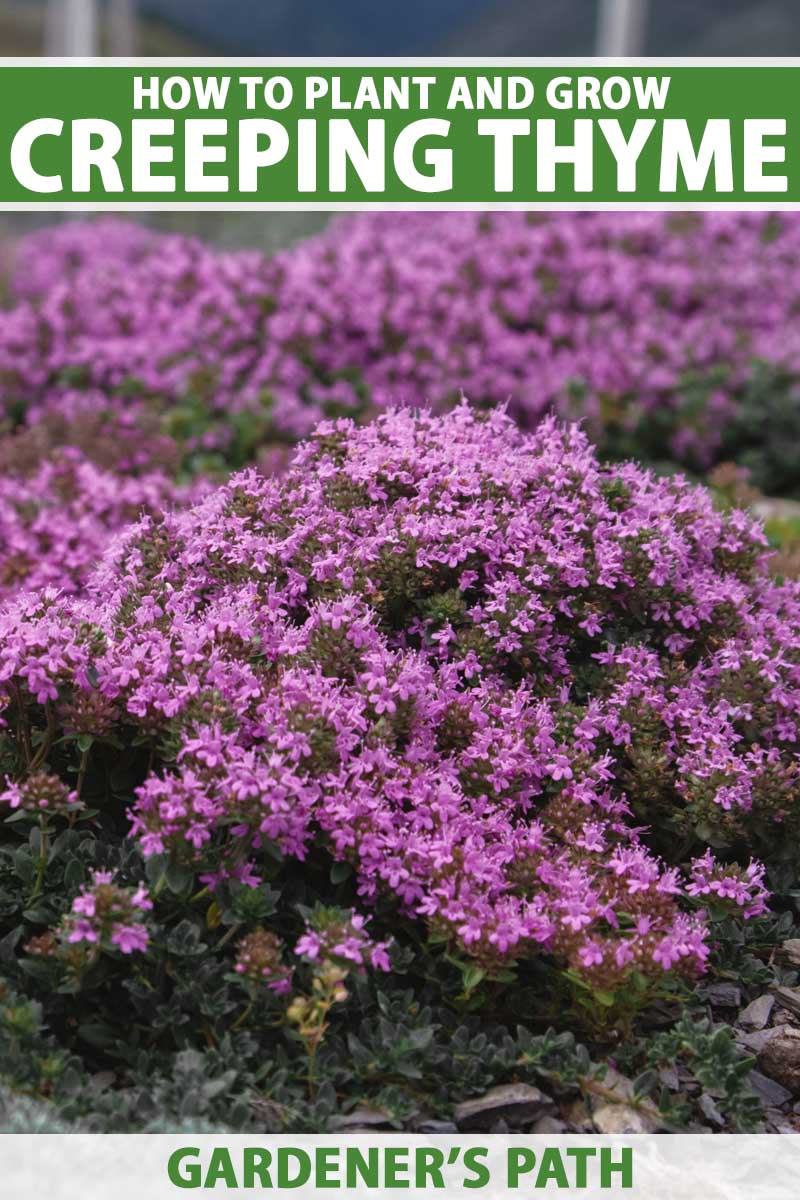
We link to vendors to help you find relevant products. If you buy from one of our links,we may earn a commission.
Ground covers provide a myriad of uses and benefits in the garden. They function as a living mulch by shading the soil, suppressing weeds, and conserving water. All of this helps to build topsoil and prevent erosion.
With so many options to choose from, it’s easy to feel overwhelmed when selecting a ground cover. Cue creeping thyme!
Drought tolerant, evergreen, low-maintenance, and fragrant, with vibrant pink-purple flowers – what’s not to love?
This ground cover is sure to put a smile on your face no matter the season. Read on to learn how to best incorporate it into your garden.
What You’ll Learn
Cultivation and History
Growing to about two to three inches tall and spreading to more than a foot across, creeping thyme tends to grow in a dense, mat-like form.
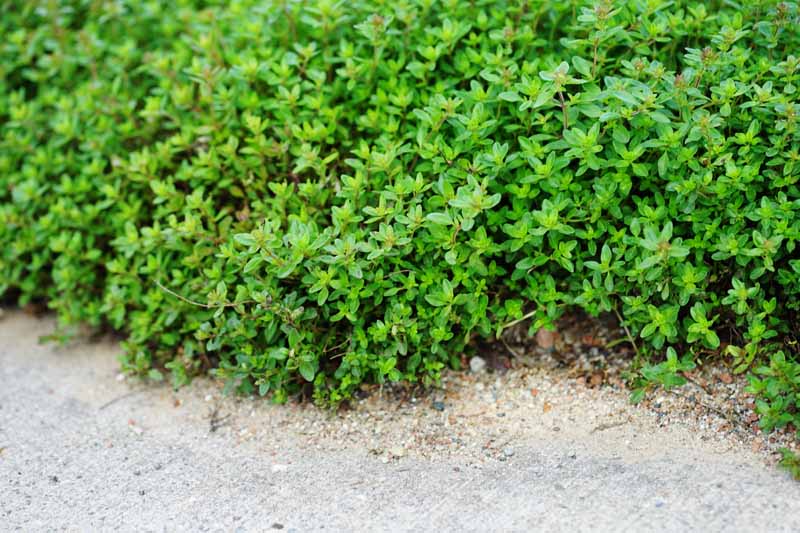
Small, fuzzy gray-green leaves are aromatic and release their fragrance when delicately crushed.
Come summertime, lavender-pink blooms attract butterflies, bees, and other friendly pollinators.
Also known as mother of thyme,T. praecoxis one of about 350 species in theThymusgenus — all aromatic herbaceous perennials native to the temperate Mediterranean climate found in parts of Europe, North Africa, and Asia.
Since antiquity, various species have been harnessed for their culinary and medicinal properties.
The name thyme is derived from the Greek word “thumos,” meaning smoke. This reference is most likely associated with the sacred practice of burning the herb as incense.
It was also used by the ancient Egyptians for embalming, and by ancient Roman soldiers to invigorate courage.
The essential oil, derived mostly from common thyme,T. vulgaris, is used in modern-day soapmaking, cosmetic and dental hygiene products, candy, and chewing gum.
Creeping thyme, not to be confused with its more culinarily-inclined cousin,T. vulgaris, is edible as well, offering a light herbal option to be used in the kitchen.
You can learn abouthow to grow common thyme in our guide.
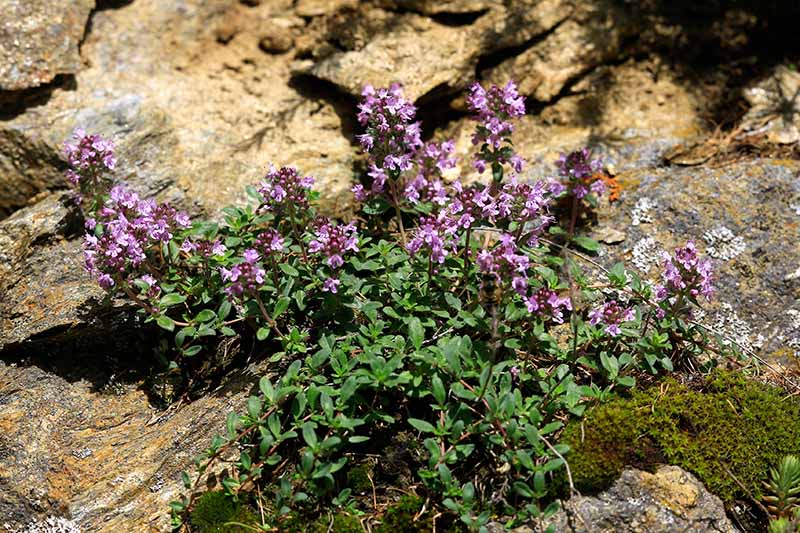
Most notably in the garden, creeping thyme’s greatest function is to work as an aromatic, pollinator-attracting ground cover.
These are excellent companion plants for vegetable gardeners to utilize, and they can serve to smooth out any harsh corners in hardscaping.
Propagation
A low-maintenance plant once established,T. praecoxdoes require a little TLC to get started.
You can elect to sow seeds or plant starts; both options will lead to lush, green growth in no thyme (ha!).
From Seed
Sow seeds either indoors,in a greenhouse, or directly outdoors after the danger of frost has passed. Seeds typically germinate within seven to 21 days at 65 to 70°F.
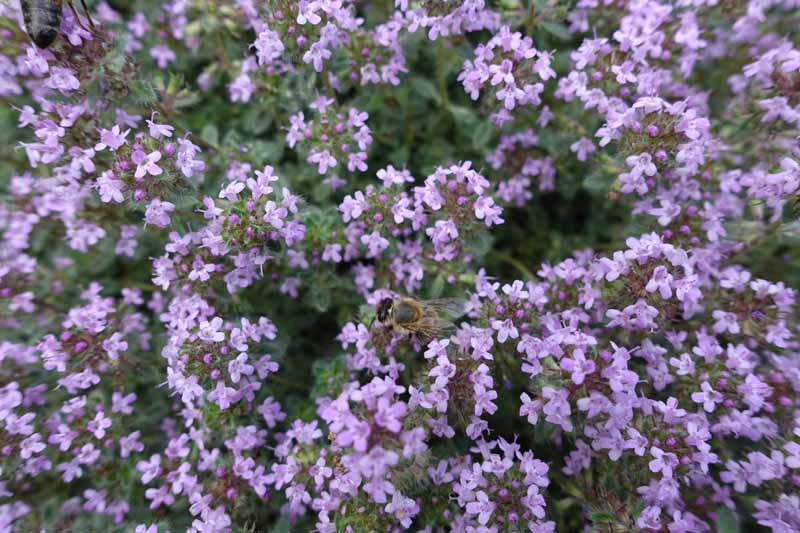
For growing indoors, sow seeds inorganic potting soil在托盘或两英寸的容器。撒上seeds on top of the soil or covered lightly to a depth of 1/16 of an inch at most, and maintain consistent moisture for germination.
Thin to two to three seedlings per container. After the seedlings have established roots and grown to an inch or two in height, they may then be moved outside.
You can acclimate the plants by moving them outside during the day and keeping them inside at night, increasing the amount of time they spend outdoors by about an hour or so each day.
Hardening them off in this way allows the seedlings to get used to their new environment and reduces the risk of shock when they are planted outside.
For outdoor seed sowing, first prepare the planting area. Remove weeds and rake out any thick clumps of soil.
Scatter the seeds across the designated site and press them firmly into the soil, or plant two to three seeds 12 to 18 inches apart in staggered rows. Plant seeds no deeper than 1/16 of an inch.
Make sure to give them a good watering after broadcasting seeds so they don’t get whisked away by the wind, or a curious critter.
The most important (and most challenging) thing to remember with direct seeding is keep the planting area consistently moist.
Maintain regular watering after sprouts start shooting up and incrementally ease up on watering as the plants mature.
From Seedlings or Transplanting
Alternatively, you can plant nursery starts instead of seeds.
Plant starts or transplant your seedlings in the spring, making sure the roots are buried thoroughly in the ground and the soil surface reaches the base of the plant.
Space plants about eight to 12 inches apart, giving them ample room to spread to their full size.
Give plants deep, regular watering two to three times per week for the first couple of months to help roots become established, then slowly decrease the frequency of their watering schedule as they mature.
When a year has gone by since planting time, you should be watering just once or twice a month, depending on rainfall.
By Division
Make divisions in either spring or fall for a smooth re-establishment.
Some say that the warmer weather and longer days of spring help the plants quickly gain new growth, while fall allows the plants to hunker down and invest more energy in their roots. Both timeframes seem to lead to success.
To divide, select a healthy plant and dig up the whole root ball, gently shaking out as much soil as possible.
Break it into three or four sections, each with sufficient roots and foliage to grow independently from one another.
Place each new plant back into the ground or in individual containers and give them a thorough watering.
Water these divisions as you would new transplants, two to three times per week, slowly easing up as they become more established.
How to Grow
T. praecoxenjoys dry, fast-draining soil andfull sun conditions, and it does not need to be fertilized.
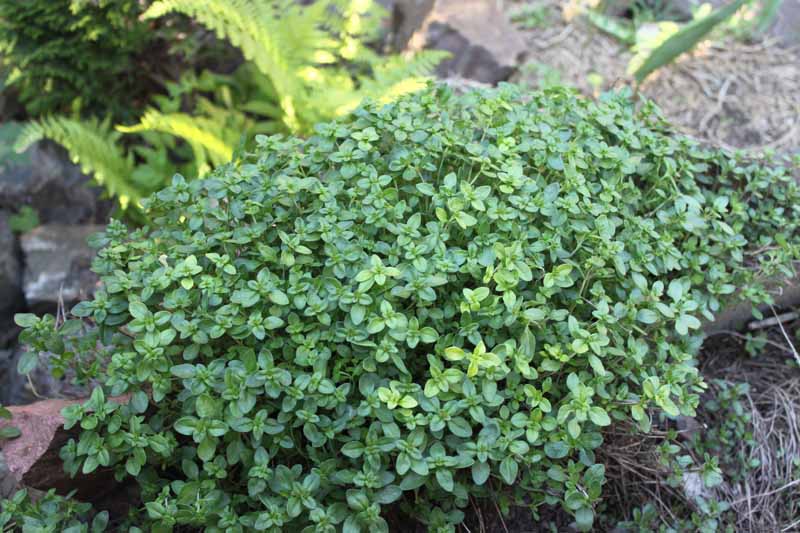
Grow it in sandy, rocky, or otherwise poor soil in areas that receive six or more hours of sunlight each day.
These little buddies are exceptionally resilient, though too much water can spell disaster.
While not the most intuitive of garden advice, it’s actually better to underwater this plant than it is to overwater, asT. praecoxis susceptible to root rot.
Growing Tips
- 选择一个晴朗的种植面积与well-drainingil.
- Prep the site by weeding and smoothing out soil clumps.
- Sow seeds directly, or plant starts.
- Water seeds daily until germination occurs.
- Give each plant ample room to grow.
- Provide regular watering as plants mature, slowly easing up on irrigation.
修剪和维护
Once established,T. praecox是一个相当不干涉花园监护人。一些occasional water here or there is all these plants really need – though not too much, as they can easily become oversaturated.
Again, fertilization is not recommended, asT. praecoxthrives in lean soil.
This plant will spread quickly within the first couple of years. Three to four years down the road, the original parent part of the plant will grow thin and should be divided as described above to encourage healthy, new growth.
Keep in mind, denser plantings provide a more immediate lush look, but over time the plants will struggle to reach for the sun, resulting in less healthy, leggier growth.
Avoid this by thinning out or transplanting divisions to other parts of your garden, so that each plant has ample space to grow.
Cultivars to Select
While the uncultivated species plant has small clusters of tubular, lilac-colored flowers, there are a few cultivars that offer different blossom colors and plant forms.
Albiflorus
‘Albiflorus’ features snow-white flowers and bright green, aromatic foliage that spreads quickly to form a dense mat.
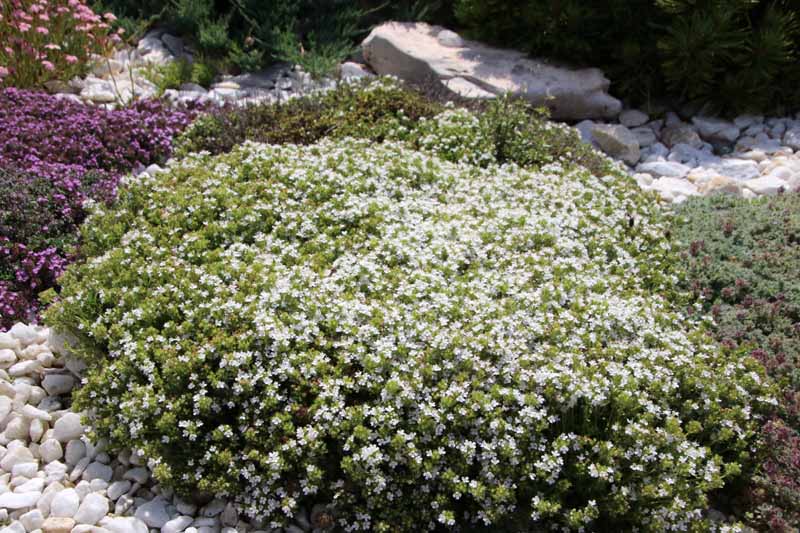
With a mature height of just two to three inches and a spread of one to two feet, it is ideal for planting in between paving stones or in rock gardens.
Coccineus
‘Coccineus’ boasts an abundance of vibrant ruby pink flower clusters.
Plants grow to a mature height of just one to two inches tall and a spread of 12 to 18 inches. Its light green foliage turns an attractive bronze color in fall.
You can find plants available for purchase in quart-size containersat Nature Hills Nursery.
Minus
‘Minus’ has the tiniest of all the thyme leaves, with small clusters of lilac-pink flowers. The miniature leaves make it look almost like moss, forming a dense ground cover.
This cultivar does not bloom as prolifically as most other cultivars, but it forms dense mats of green. Expect a mature height of one to two inches with a spread of up to 16 inches.
Managing Pests and Disease
If planted in an area with poor drainage or a section of the garden that is overwatered,T. praecoxmay be susceptible to root rot.
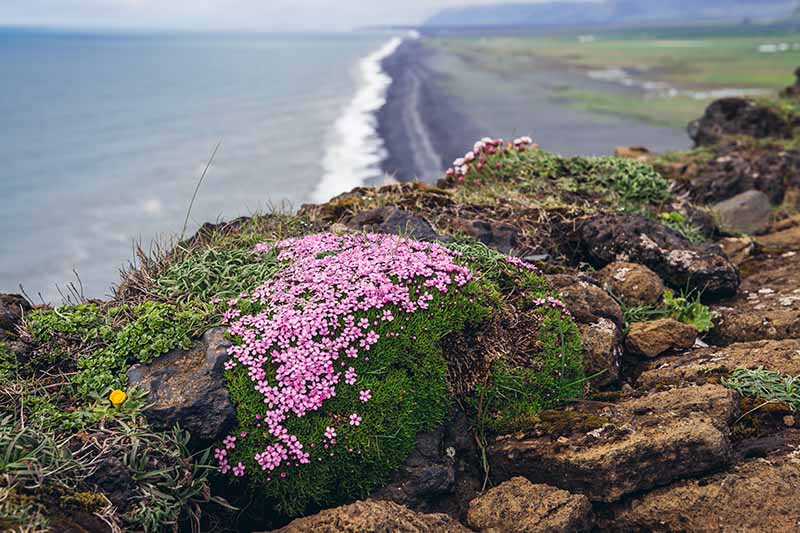
The easiest way to avoid such a fate is to ensure that the designated planting area is fairly fast-draining and kept reasonably dry.
Slugs may be an issue, but these can easily be treated with weekly applications of food-gradediatomaceous earth.
Other than that, there are no serious insect or disease problem to speak of! A gardener’s dream.
Best Uses
The dense, creeping nature of this species makes it an excellent ground cover and living mulch. As such,T. praecoxhelps to suppress weeds, conserve soil moisture, and prevent erosion.
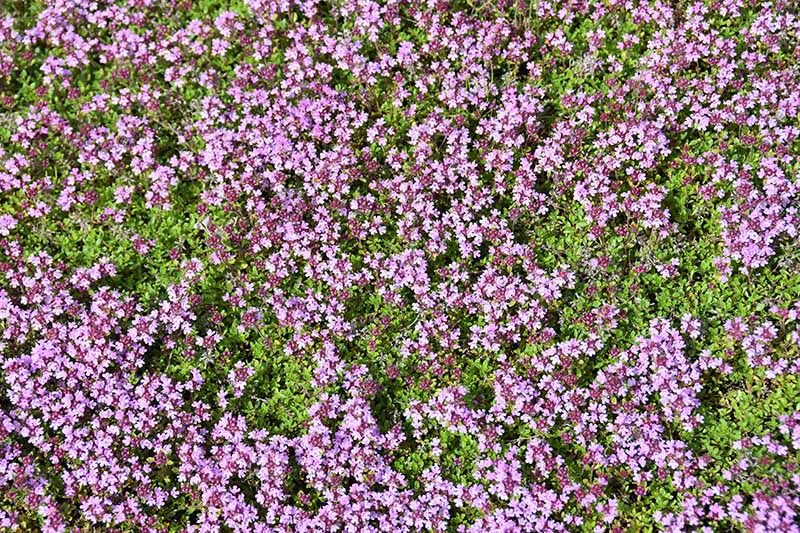
In a garden setting, this species looks best planted in a walkway, in between stepping stones or pavers, as creeping thyme is tolerant of moderate foot traffic and releases a pleasant aroma when its leaves are lightly crushed.
It also works well in rock walls or as a dainty border planting. Since each plant spreads to just over a foot wide, it’s best to plant en masse for a full-flowering, fragrant effect!
Finally, as I mentioned previously, though this is not the traditional culinary variety (T. vulgaris), the leaves ofT. praecoxare still edible and will provide a tasty flavor to any stew, sauce, or salad.
Quick Reference Growing Guide
| Plant Type: | Perennial woody shrub | Flower/Foliage Color: | Pink, purple, white/silvery green |
| Native to: | Southern, western, and central Europe | Maintenance: | Low |
| Hardiness (USDA Zone): | 5a-8b | Tolerance: | 鹿、干旱、脚traffic, poor soil |
| Season: | Summer | Soil Type: | Dry, sandy, rocky |
| Exposure: | Full sun | Soil pH: | 6.0-8.0 |
| Spacing: | Thin to 1 inch (seeds), 8-12 inches (transplants) | Soil Drainage: | Well draining |
| Planting Depth: | 1/16 inch (seeds), depth of container (transplants) | Attracts: | Butterflies |
| Height: | 2-6 inches | Uses: | Border plant, ground cover, pollinator attractor |
| Spread: | 4-12 inches | Family: | Lamiaceae |
| Water Needs: | Low to Moderate | Genus: | Thymus |
| Common Pests and Disease: | Slugs; root rot | Species: | Praecox |
Welcome to the Garden
Creeping thyme makes for a delightful and delicate addition to any full sun garden.
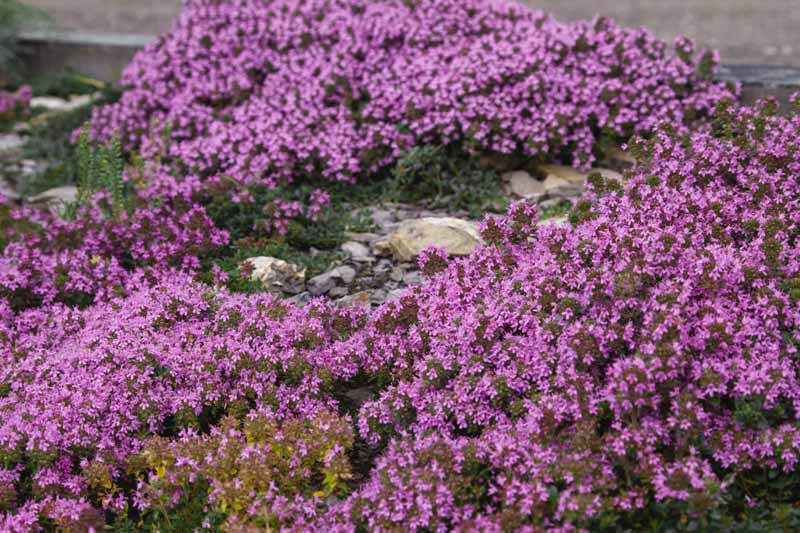
With small aromatic silvery-green leaves and vibrant lavender-pink or white flower clusters, this festive ground cover may just creep right out of the nursery and into your heart!
If you have experience growing creeping thyme in your garden or have any questions, drop a comment below — we’d love to hear your feedback!
And for more information on growing otherground covers, check out these articles next:




